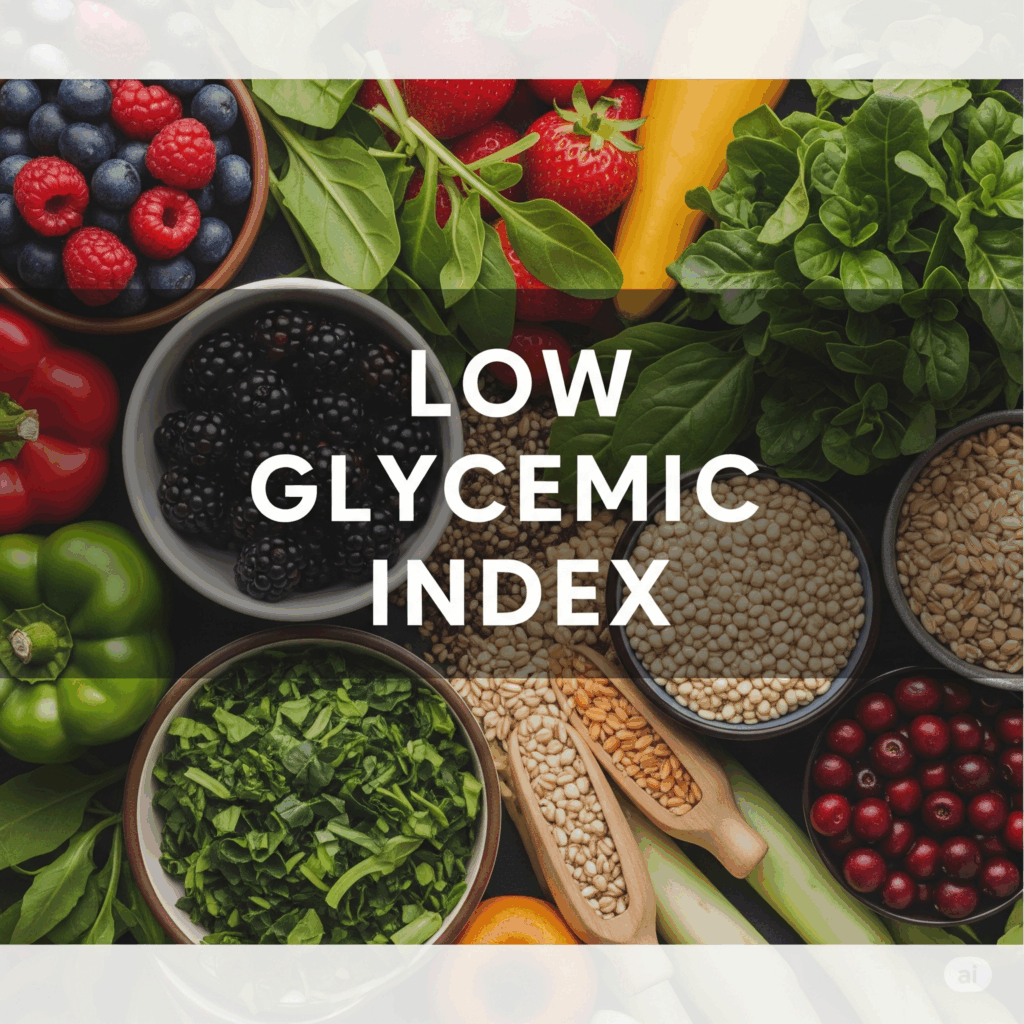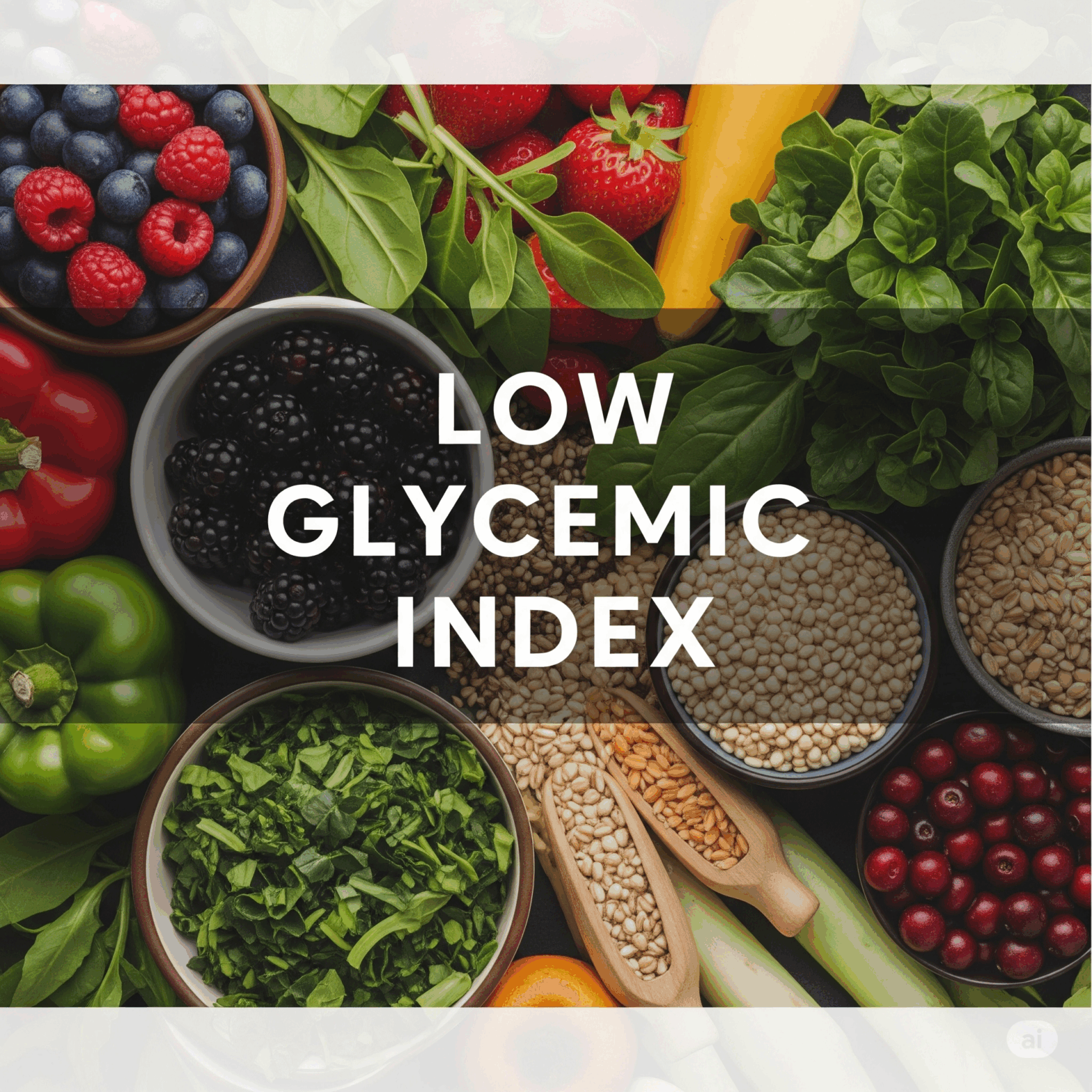I. Introduction: Demystifying the Glycemic Index
The Glycemic Index (GI) serves as a crucial tool in nutritional science, classifying carbohydrate-containing foods based on their immediate impact on blood glucose levels after consumption.
This system quantifies how quickly and significantly a food raises blood sugar, comparing it to a reference food, typically pure glucose, which is assigned a GI value of 100. ‘=
Understanding this ranking is fundamental for dietary management, particularly for individuals focused on metabolic health.
Table of Contents
Foods Are Categorized Into Three Distinct Glycemic Index Levels
Low GI: Foods with a GI value of 55 or less are considered low-glycemic. They lead to a slow and gradual rise in blood sugar, promoting stable glucose levels.
Moderate GI: Foods falling within the 56-69 range are classified as moderate-glycemic. Their impact on blood sugar is moderate, neither rapid nor excessively slow.
High GI: Foods with a GI value of 70 or higher are high-glycemic. These carbohydrates are rapidly digested and absorbed, causing a swift and substantial increase in blood sugar.
Glycemic Index Levels
Low GI: Foods with a GI value of 55 or less.
Moderate GI: Foods falling within the 56-69 range
High GI: Foods with a GI value of 70 or higher

Significance Of The Glycemic Index
The significance of the GI extends beyond mere classification; it is a vital metric for maintaining optimal health. For individuals, especially those with or at risk of Type 2 Diabetes, meticulous management of blood sugar levels is paramount to prevent long-term complications and enhance overall well-being. Incorporating low GI foods into the diet is a strategic approach to achieve this stability.
These foods mitigate sharp blood sugar spikes and subsequent crashes, which are critical for sustaining energy levels, regulating mood, and supporting long-term metabolic health. Furthermore, a dietary pattern emphasizing low GI foods can contribute positively to weight management, lead to improvements in A1C levels (a key indicator of long-term blood sugar control), and reduce the risk of cardiovascular disease—all common health concerns for those managing diabetes.
The glycemic impact of a food is not merely a static number; it is a dynamic outcome influenced by multiple interacting factors. A food’s GI tends to be lower when it is less processed, contains higher amounts of fiber, protein, and/or fat, and is lower in refined sugar and starch. For instance, raw carrots exhibit a lower GI than cooked ones, and al dente pasta has a lower GI than well-cooked pasta.
Even the ripeness of a fruit, such as a banana, can alter its glycemic response. This understanding highlights that the glycemic effect is a complex interplay of a food’s structural integrity, its macronutrient composition, and even its preparation methods. Recognizing these underlying determinants empowers individuals to make more informed dietary choices, even for foods not explicitly listed with a GI value.
By considering how processing, cooking techniques, and ripeness influence a food’s characteristics, individuals can better predict and manage its potential impact on their blood sugar levels. This deeper comprehension reveals a direct relationship between food properties and glycemic outcomes.

A food’s GI tends to be lower when it:
- is less processed,
- contains higher amounts of fiber, protein, and/or fat,
- and is lower in refined sugar and starch.
Riper foods have a higher glycemic index
II. Curated List: 15 Low Glycemic Index Sweet Foods and Chocolates
This section provides a carefully curated list of sweet foods and chocolate varieties recognized for their low glycemic index. This selection offers practical options for individuals seeking to satisfy a sweet craving while maintaining stable blood sugar levels.
Table 1: Low Glycemic Index Sweet Foods and Their Values
This table is presented as a direct and accessible reference, fulfilling the primary request for a list of 15 low GI sweet foods and chocolate with their values. Its structured format allows for quick comparison and informed selection, making it a valuable resource for practical dietary planning.
| Food Item | Glycemic Index (GI) | Key Characteristic/Note |
| Dark Chocolate (>70% cocoa) | 22 | Rich in flavanols, lower in sugar; supports heart health and insulin sensitivity when consumed in moderation. |
| Cherries | 22 | High in anthocyanins, which may reduce blood sugar and increase insulin production; rich in vitamins and fiber. |
| Late-Ripening Plums | 24 | Low in calories and rich in fiber, beneficial for digestion and heart health. |
| Grapefruit | 25 | Composed of 91% water, rich in vitamin C and soluble fiber; contains naringenin, which may increase insulin sensitivity. |
| Indian Jujube | 25 | Traditionally recognized for its potential in managing high blood sugar levels. |
| Peach | 28 | Good source of fiber, antioxidants, and vitamins; a refreshing low-GI option. |
| Spring Peach | 30 | A less common peach variety, beneficial for reducing the risk of Type 2 Diabetes. |
| Figs | 35 | Contains natural sugars balanced by fiber; best consumed whole and fresh. |
| Pear | 38 | High in water and fiber, helps increase insulin sensitivity and manage blood sugar. |
| Apple | 39 | Rich in vitamin C, soluble fiber, and pectin, which aids in toxin removal and may reduce insulin requirements. |
| Kiwi | 39 | A good source of fiber and vitamins, contributing to stable blood sugar levels. |
| Mountain Tamarind | 40 | Rich in vitamin C and fiber, suitable for daily consumption in a diabetic diet. |
| Strawberries | 41 | Packed with vitamins, antioxidants, and fiber, helping to control diabetes and curb hunger. |
| Orange | 42 | High in fiber and vitamin C, with low sugar content, aiding in blood sugar control and weight management. |
| Blueberries | 53 | High in antioxidants and fiber, contributing to overall health and blood sugar stability. |
The consistent presence of low GI values across a variety of natural fruits, such as berries, apples, and pears, underscores a fundamental principle of balanced sugar delivery inherent in nature. This phenomenon is largely attributable to the high fiber content found in these fruits. Fiber slows down the digestion and absorption of natural sugars, preventing rapid blood glucose spikes.
This pattern suggests that whole, natural fruits, despite their sugar content, are generally safe and beneficial choices for blood sugar management due to their inherent structural and nutritional composition.
While natural fruits offer inherent low-GI benefits, the development of “prepared” low-GI sweet options demonstrates that strategic ingredient substitutions are pivotal in transforming traditional, high-GI desserts into healthier alternatives. For instance, recipes utilizing coconut flour instead of refined flour, coconut sugar or erythritol in place of refined sugar, raw cacao for its antioxidant properties, and sugar-free chocolate chips are highlighted as effective modifications.
This approach goes beyond simply listing low-GI foods; it illustrates a practical methodology for creating sweet treats that align with glycemic management principles. It reveals that with careful selection and innovative culinary techniques, individuals can enjoy a broader range of sweet foods without compromising blood sugar stability.
III. The Sweet Science of Low GI Chocolate
Chocolate, often perceived as a high-sugar indulgence, can indeed be part of a low-GI diet, particularly when focusing on varieties with higher cocoa content. The glycemic index of chocolate varies significantly depending on its composition, primarily its cocoa percentage and added sugar content.
Dark chocolate, especially varieties with over 70% cocoa, boasts the lowest GI, typically around 22. In contrast, milk chocolate has a GI of approximately 45, while white chocolate, which contains no cocoa solids and is higher in sugar and fat, has the highest GI, ranging from 45 to 60.
This clear inverse relationship between cocoa content and GI in chocolate reveals that the primary driver of glycemic response is the amount of added sugar, not the cocoa itself. As dark chocolate contains less sugar and more fiber, its digestion and absorption are slowed, leading to a more gradual rise in blood sugar levels.
Beyond its favorable glycemic profile, high-cocoa dark chocolate offers notable health benefits. It is rich in flavanols, potent antioxidants that have been shown to improve insulin sensitivity, potentially lower blood pressure, and optimize glucose metabolism. Furthermore, dark chocolate provides essential minerals such as magnesium, iron, and vitamin E.
To reap these benefits, consuming around 40 grams of chocolate with over 70% cocoa content, which provides approximately 200 mg of flavanols, is recommended by authorities like the European Food Safety Authority (EFSA). While milk and white chocolate can still be enjoyed in moderation, understanding their higher sugar and fat content is crucial for effective diabetes management.

IV. Smart Strategies for Low GI Sweet Indulgences
Incorporating low GI sweet foods into a daily diet requires more than just knowing a list of items; it involves strategic planning and mindful consumption. The principles that make a food low GI can also be applied to modify and prepare healthier sweet treats at home.
Key ingredients and substitutions are central to this approach. As previously discussed, using fiber-rich flours like coconut or almond flour, and natural or sugar substitutes such as erythritol or small amounts of honey, can significantly lower the glycemic impact of desserts. Raw cacao and sugar-free chocolate chips are also excellent choices for adding flavor without excessive sugar. These substitutions are not merely replacements; they represent a fundamental shift in how sweet foods are constructed to support metabolic health.
Portion control is another critical strategy, regardless of a food’s GI value. Even low GI foods can impact blood sugar if consumed in large quantities. Learning appropriate portion sizes, perhaps by using visual guides like the “plate method” (where healthy carbohydrates occupy one-quarter of a 9-inch plate), can help manage overall carbohydrate intake.
Furthermore, the overall composition of a meal or snack can significantly influence its glycemic response. Combining carbohydrates, even those with a moderate GI, with sources of protein, fiber, and healthy fats can slow down glucose absorption and lead to a more gradual rise in blood sugar. For example, pairing a piece of fruit with a handful of nuts or a spoonful of nut butter can mitigate the fruit’s sugar impact.
This emphasis on combining macronutrients suggests a holistic approach to glycemic management, where the synergy of the entire meal can effectively temper the blood sugar impact, rather than solely relying on the individual GI values of each food component. This highlights that meal planning extends beyond simple food selection to encompass strategic nutrient pairing.
Finally, preparation methods and ripeness also play a role. Less processed foods generally have a lower GI. For fruits, choosing those that are less ripe can result in a lower glycemic impact. When cooking, opting for methods that preserve fiber and avoid excessive breakdown of carbohydrates can also be beneficial.
V. Broader Dietary Principles for Blood Sugar Health
While focusing on low GI sweet foods is beneficial, it is crucial to integrate these choices within a broader, balanced eating pattern for comprehensive blood sugar management and overall health. The American Diabetes Association (ADA) and Mayo Clinic emphasize that there isn’t a single “diabetes diet” that fits everyone; rather, personalized meal plans based on scientifically proven patterns are recommended.
Several meal patterns have demonstrated effectiveness in managing diabetes, including the Mediterranean-Style, Vegetarian/Vegan, Low-Fat, Very Low-Fat, Low Carbohydrate, Very Low Carbohydrate, and Dietary Approaches to Stop Hypertension (DASH) patterns. Common threads among these beneficial approaches include an abundance of non-starchy vegetables, high-quality proteins (such as beans, nuts, seeds, lean meats, poultry, and fish), and healthy fats (like olive oil and avocado). Whole grains are also consistently recommended due to their fiber content, which helps stabilize blood sugar levels.
A simple and effective visual tool for meal planning is the “plate method.” This approach suggests filling half of a 9-inch plate with non-starchy vegetables (e.g., lettuce, broccoli, tomatoes), one-quarter with lean protein (e.g., fish, beans, lean meat), and the remaining quarter with healthy carbohydrates (e.g., fruits, whole grains). This method inherently promotes balanced macronutrient intake and portion control.
A consistent and fundamental principle across all recommended dietary patterns for blood sugar management is the imperative to limit refined carbohydrates and added sugars. Multiple authoritative sources, including the Mayo Clinic and the American Diabetes Association, consistently advise reducing intake of items like white bread, white rice, sugary cereals, cakes, cookies, candy, chips, and sugar-sweetened beverages.
This recurring emphasis underscores that minimizing these highly processed and sugar-laden foods is a foundational strategy for effective blood sugar control, often carrying more significant impact than merely selecting low-GI sweet alternatives. This highlights a critical guideline for anyone managing blood sugar, suggesting it is a primary lever for metabolic health.
While the primary focus of this report is on “sweet foods,” a notable pattern emerges from the research: natural fruits are frequently highlighted as the optimal low-GI sweet options due to their inherent fiber content and rich nutrient profiles. This stands in contrast to processed “sweets” that often necessitate significant modifications and ingredient substitutions to achieve a low-GI status.
This distinction points to a divergence between naturally occurring low-GI sweetness and engineered low-GI treats. It implies that prioritizing whole, natural fruits offers a more straightforward and nutrient-dense path to satisfying sweet cravings while effectively managing blood sugar, often requiring less dietary manipulation than their processed counterparts.
VI. Conclusion: Empowering Your Sweet Choices
Managing blood sugar levels effectively, whether for general health or in the context of diabetes, does not necessitate the complete elimination of sweet foods. By understanding and applying the principles of the Glycemic Index, individuals can make informed choices that allow for mindful indulgence while supporting metabolic health. The selection of low GI sweet foods, particularly natural fruits and high-cocoa dark chocolate, provides delicious and nutritious options that contribute to stable blood sugar levels.
The successful integration of these foods into a healthy lifestyle hinges on several key factors: moderation, portion control, and the synergistic combination of carbohydrates with protein, fiber, and healthy fats. It is also important to remember that individual responses to food can vary, and a personalized approach to nutrition is often the most effective.
The consistent advice from leading health organizations to consult healthcare professionals or registered dietitians underscores that managing blood sugar, even with the knowledge of low-GI foods, is a complex and highly individualized endeavor. While general information and lists are valuable starting points, a professional can provide tailored guidance that considers unique health profiles, dietary preferences, and lifestyle factors.
This personalized support is essential for developing sustainable eating habits and achieving long-term health goals, acknowledging the limitations of a generic report and highlighting the necessity of expert partnership in one’s health journey.
